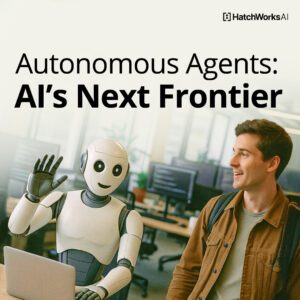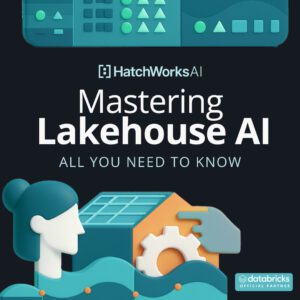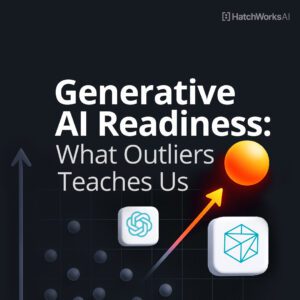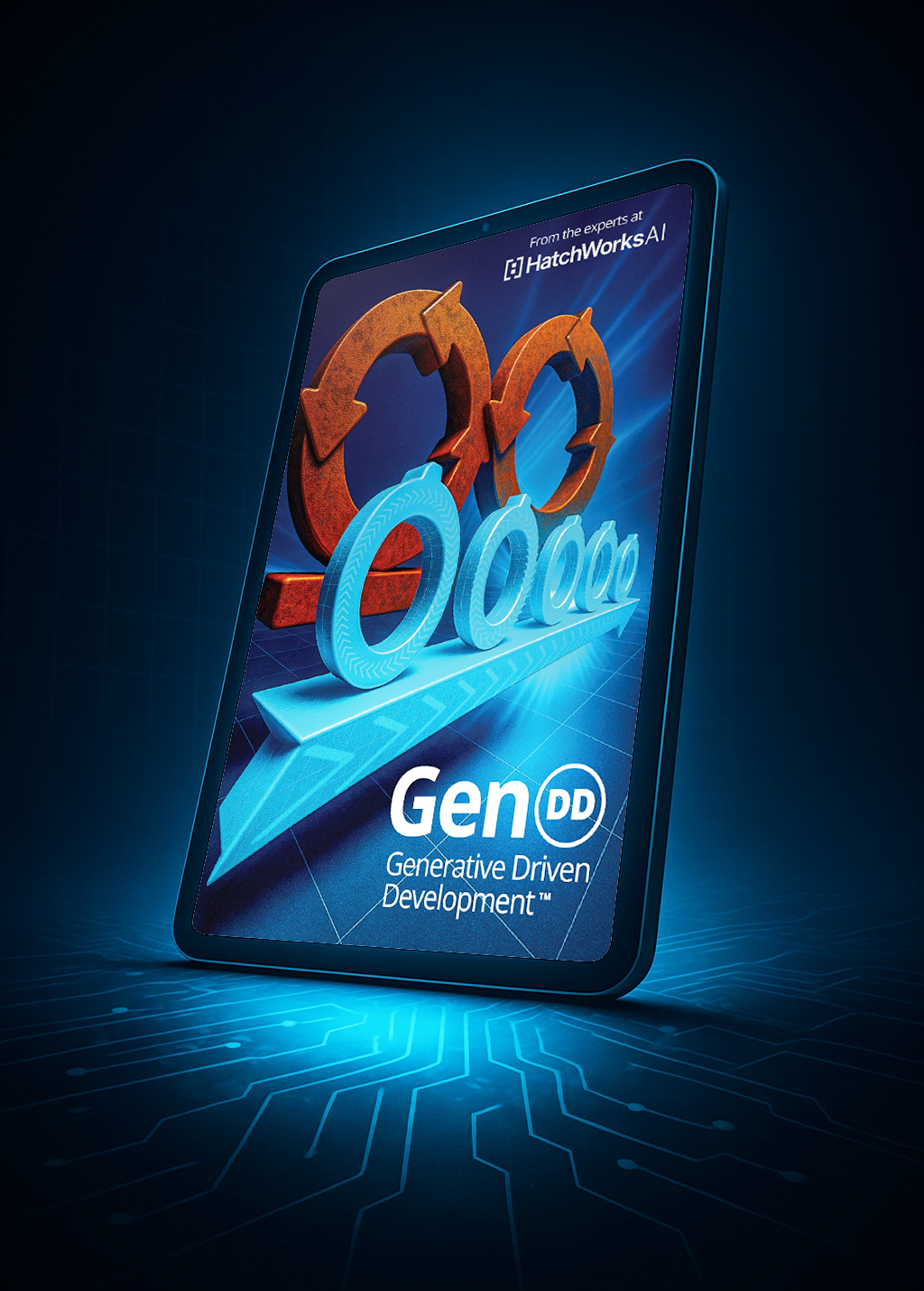You don’t get into business to lose to your competitors. But every day your team doesn’t embrace GenAI into their work is a day you risk exactly that.
But how do you make team adoption of GenAI seamless and efficient?
In this guide, we show you how to boost you gen AI capabilities.
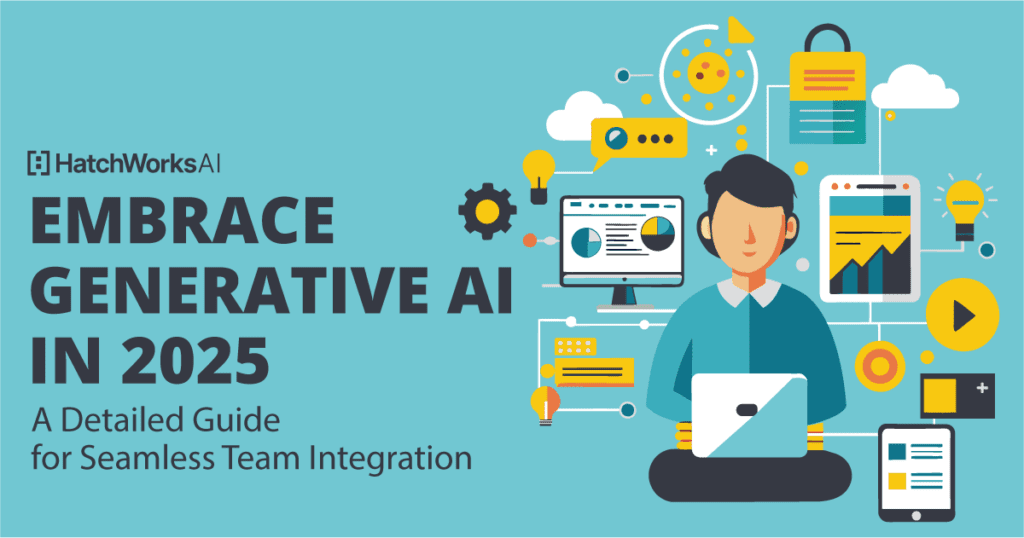
Understanding Generative AI and Its Capabilities
📚 For a full introduction to GenAI, check out our article: Getting Started with Generative AI: A Beginner’s Guide to Mastery.
Generative AI (or GenAI) is a form of artificial intelligence that creates new content based on its training of billions of parameters.
In other words, it generates something unique based on its understanding of patterns, relationships, and structures within the data it has been trained on.
‘New content’ can include:
- Text
- Imagery
- Video
- Sound
- Code
GenAI is built on LLMs that use Transformer architecture, which is what makes it so intuitive to what users are asking of it.
This is important for understanding the context of user prompts and generating appropriate and accurate outputs. It’s the Transformer architecture that made ChatGPT so impressive upon its release in 2022. In fact, the T in GPT stands for ‘Transformer’.
What exactly is GenAI capable of?
We can’t list every use case, it would take too long and users of Gen AI are discovering new ones every day. So instead, we’ve listed some of our favorite applications:
- Writing articles and automating content creation for a blog post, social media, and news outlets.
- Generating code, automating testing, and debugging, speeding up the software development process.
- Tailoring content, ads, and campaigns to individual preferences and behaviors, enhancing customer engagement and conversion rates.
- Producing original artworks, illustrations, and graphic designs from textual descriptions or by mimicking specific artistic styles.
- Creating new music pieces in various genres or styles, aiding composers in exploring new melodies and arrangements.
- Generating dynamic video game environments, NPC behaviors, and storylines, creating more immersive gaming experiences.
- Modeling financial markets for predictive analysis, risk assessment, and investment strategy formulation.
- Assisting in drug discovery and personalized medicine by generating molecular structures and simulating their effects.
McKinsey’s research has revealed software development to be one of the industries most ripe for productivity enhancement and the data illustrates just which business functions have been quick to adopt Generative AI in their business processes.
Check out the image below to see how software engineering for corporate IT and product development are the two sitting in the top right corner of the chart:
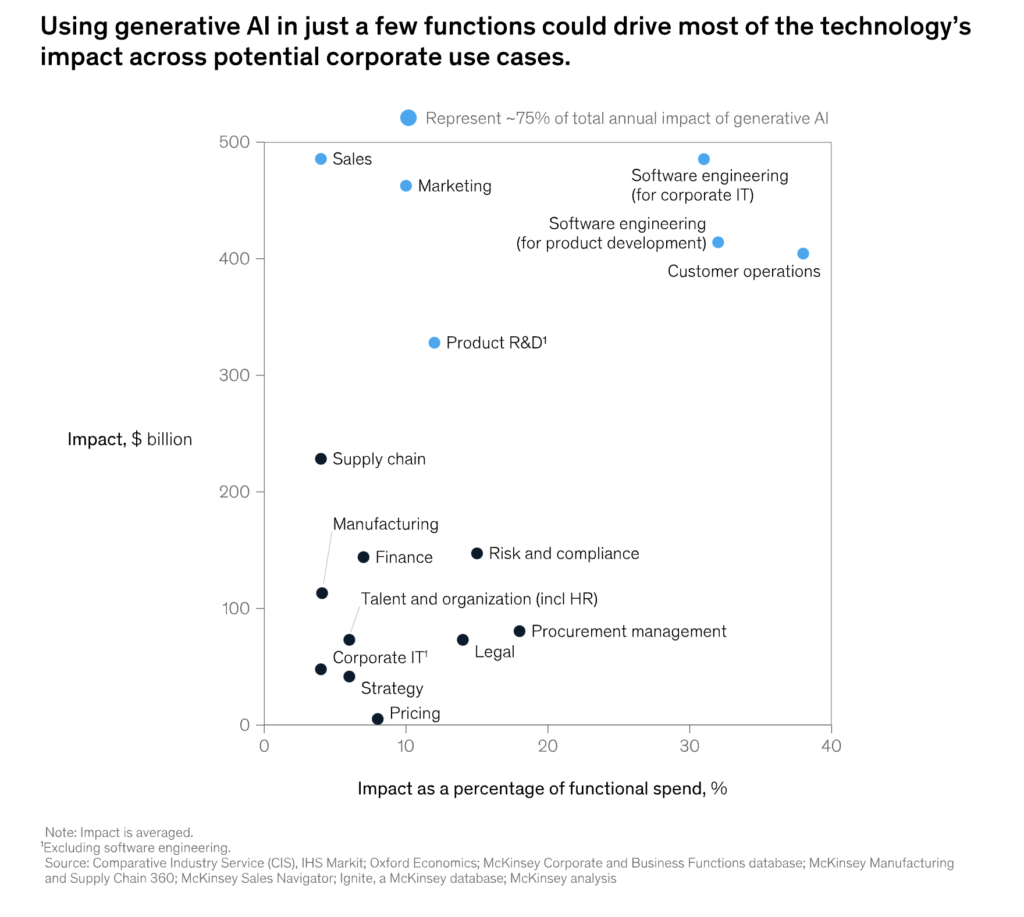
Team Adoption: Generative AI on Productivity and Innovation
The driving force behind team adoption rate of Generative AI? It’s potential to boost employee productivity and innovation.
And that potential is already being realized. The Nielsen Norman Group completed a study that shows use of Gen AI can boost employee labor productivity by up to 66%. This was observed across three case studies:
Study 1: Support agents who used AI could handle 13.8% more customer inquiries per hour.
Study 2: Business professionals who used AI could write 59% more business documents per hour.
Study 3: Programmers who used AI could code 126% more projects per week.

What’s interesting about Generative AI is that it’s poised to impact knowledge-based industries. Compare that to past AI technological advancements which largely affected businesses in the manufacturing industry. McKinsey attributes this to Generative AI’s unique strengths in language-based activities.
While our estimates suggest that tech companies, unsurprisingly, are poised to see the highest impact from gen AI—adding value equivalent to as much as 9 percent of global industry revenue—knowledge-based industries such as banking (up to 5 percent), pharmaceuticals and medical products (also up to 5 percent), and education (up to 4 percent) could experience significant effects as well."
From McKinsey
McKinsey calls early and prolific adopters of Gen AI, ‘AI high performers’ and in their research, it was revealed these high performers can attribute at least 20 percent of EBIT (earnings before interest and tax) to AI use in 2022.
Given how quickly Generative AI has (and still is advancing) since 2022, that number is only set to increase.
📚 Further reading: Generative AI Statistics: The 2024 Landscape – Emerging Trends, and Developer Insights
Laying the Groundwork for Team Adoption of Generative AI
There’s so much to be gained from rapid adoption of Generative AI but your ability to, and the speed at which you gain it, is dependent on how you introduce this new technology to your business.
Key considerations for successful adoption are:
- How ready your team is to embrace and integrate AI into their work
- What Generative AI tools will suit your business needs, capabilities, and applications of AI
Let’s look at each of those points in turn.
Assessing Your Team’s Readiness for Generative AI Integration
How primed is your organization for Generative AI? You may not even know how to answer that question. And that’s okay. In this section, we’re looking at two ways you can assess your team’s readiness.
The first is by identifying skill gaps and future training needs related to Generative AI.
No doubt, some teams will be more ready than others, and some individuals will be more advanced in AI knowledge even within those teams.
You need to understand where those gaps in knowledge and expertise are and how deep they go. Have they heard of prompt engineering? Do they know how to prompt? How have they experimented with AI and what results have they seen?
💡 Practical tip: Speak to managers and run an internal survey to gauge where your employees are. Make sure you’re transparent about why you’re investigating so that your employees feel safe sharing.
From there you can determine how to upskill employees through online courses, coaching and mentorships between team members, lunch and learns, on-the-job experimentation, and more.
After this, you need to evaluate existing workflows and find where AI has its greatest potential.
Check out our podcast episode where Jason Schlachter, Founder at AI Empowerment Group shares how to identify the best AI use cases in your org:
You want to find tasks and processes that could be enhanced or automated with AI.
You want to identify both high-impact areas and quick wins where AI can demonstrate immediate value.
Here are some steps you can take:
1. Document Current Workflows:
- Map out the current processes in detail.
- Identify the steps, tasks, and decision points in each process.
2. Identify Repetitive and Time-Consuming Tasks:
- Highlight tasks that are manual, repetitive, and don’t require deep decision-making.
- These tasks are often the low-hanging fruits for AI automation.
3. Assess Data-Intensive Processes:
- Pinpoint processes that involve handling large volumes of data.
- Generative AI can enhance data analysis, pattern recognition, and decision-making.
4. Evaluate Creative and Content Generation Tasks:
- Identify areas involving content creation, design, or any form of creative output.
- AI tools can assist in generating new content, designs, or even code.
5. Analyze Customer Interaction Points:
- Look at how and where your team interacts with customers.
- AI can personalize customer experiences and automate responses.
6. Review Decision-Making Processes:
- Identify decision-making points that rely on complex data analysis.
- AI can provide predictive insights and help in making more informed decisions.
But you also don’t want to spend too long in this phase. Experimentation and iteration will be your best bet with AI. It also helps to look at how AI is being used by others. Ask your teams to do some digging into use cases within their respective fields.
Selecting the Right Generative AI Tools for Your Team
There’s no use training your team on Midjourney if what they really need is CoPilot.
So just as important as the processes you augment with AI are the tools you use to do it. Here are some of the most transformative and useful emerging technologies for Gen AI:
| For Content Creation and Copywriting | For Data Analysis and Insights |
|---|---|
|
ChatGPT 3 & 4 (OpenAI): Offers advanced language models capable of generating human-like text, ideal for content creation, customer service, and more.
Copy.ai: Specializes in creating marketing copy, including social media posts, emails, and blog content.
|
GPT-3 & 4 for Analytics: Uses natural language to query data, generate reports, and provide insights, making data analysis accessible to non-technical team members.
|
| For Code Generation and Software Development | For Design and Art |
|---|---|
|
GitHub Copilot: Powered by OpenAI, it assists developers by suggesting lines of code and functions, improving productivity in coding tasks.
Devin AI: The first AI platform to build a fully autonomous AI software engineer. As of April 2024 it’s waitlist only but an exciting development to check out.
|
DALL-E 2 (OpenAI): Generates original, high-quality images and art from textual descriptions, useful for designers seeking inspiration or specific visual content.
MidJourney: Transforms textual prompts into unique, detailed visuals, offering a wide range of styles for creative exploration.
|
| For Personalized Customer Experiences |
|---|
|
Replika: Creates personalized chatbots for customer service and engagement, learning from interactions to provide tailored responses.
|
When selecting your tools, make sure to consider:
- Functionality and relevance
- Ease of use and integration
- Scalability
- Support systems and resource database
- Ethical guidelines and bias mitigation
- Cost
- Data security and compliance
Your teams will have an idea of what tools will best suit their needs, so don’t be afraid to ask them and then vet them with the above list.
Strategies for Seamless Integration of Generative AI into Your Team
Adopting Generative AI, or any new technology, into your organization or business is made easier when you have a strategy in place.
Here we’ll help you come up with a plan and show you how to overcome the most common challenges that crop up in Generative AI adoption.
How to Develop a Plan for Generative AI Adoption
Some of these steps will incorporate actions we’ve already discussed such as an assessment of needs, training considerations, and selection of tools.
We wanted to highlight them again within the context of a wider strategy and to show exactly what steps make for a seamless integration of AI into your business:
1. Define Clear Objectives and AI Strategy
- Identify Specific Goals: Start by pinpointing what you aim to achieve with Generative AI. Goals could range from enhancing creativity in design, improving content generation speed, to automating routine tasks.
- Set Measurable Milestones: Break down your main objectives into measurable milestones. This could include timelines for training completion, pilot project launches, or specific performance improvements you aim to see.
2. Encourage Your People to Just Start
- Empower Experimentation: Encourage team members to experiment with Generative AI on small scales within their current projects.
- Facilitate Community Learning: Tell your team to seek education and learning in communities championing AI use. And if you have internal AI champions or ‘AI high performers’, have them lead Lunch and Learns with deep dives into specific AI-related topics.
3. Assess Current Capabilities and Needs
- Conduct a Technology Audit: Review your existing tech stack to identify potential integration points and any gaps that Generative AI can fill.
- Evaluate Skills and Knowledge: Assess the current skill level of your team regarding AI. Identify any areas where training or hiring may be necessary.
4. Plan for Education and Training
- Select Appropriate Training Programs: Choose online courses, workshops, or seminars that match your team’s needs. Consider both general AI literacy programs and specific training on the AI you plan to adopt.
- Schedule Training Sessions: Set a timeline for training that aligns with your overall implementation schedule, ensuring your team has the necessary knowledge before the tools are rolled out.
5. Involve Team Members in the Planning Process
- Gather Input and Feedback: Host brainstorming sessions or surveys to involve your team in the planning process. This can help identify unseen opportunities or concerns.
- Assign Roles and Responsibilities: Clearly define who will be responsible for each part of the AI integration process. This includes managing the tools, training, and monitoring progress.
6. Choose the Right GenAI Tools
- Match Tools with Objectives: Based on your defined goals, select Generative AI tools that best fit your needs. Consider the overview of tools provided earlier for various functions.
- Trial and Evaluate: Test with pilot projects or trials to evaluate their effectiveness and ease of integration into your workflows.
7. Implement a Pilot Project
- Start Small: Choose a low-risk project or task to begin integrating Generative AI. This allows you to troubleshoot and make adjustments in a controlled environment.
- Monitor and Adjust: Collect data on the pilot project’s performance. Use this information to tweak your approach, training, or even the tools themselves.
At HatchWorks, we had our VP of Marketing & Strategy (who doubles as our resident AI expert) lead the company in an internal workshop. In it, everyone built their own custom GPT meant to solve problems in our existing internal workflows or enhance our ability to accelerate software development for our clients.
8. Scale and Expand
- Review Pilot Project Results: Assess what worked and what didn’t. Identify lessons learned and areas for improvement.
- Plan for Broader Integration: Based on the pilot’s success, develop a plan for wider implementation of Generative AI within your organization, incorporating more projects and teams.
- Set Long-Term Goals: As your team becomes more comfortable with Generative AI, set new goals for further integration and optimization.
9. Continuously Monitor and Iterate
- Track Performance and Feedback: Continuously monitor the impact of Generative AI on your workflows and collect team feedback.
- Iterate Based on Learnings: Use the insights gained from ongoing monitoring to make iterative improvements to your Generative AI strategy.
Overcoming Common Challenges in Generative AI Adoption
Odds are, your first buy in the AI adoption process won’t be all smooth sailing. But if you know what you’re up against and prepare correctly, you’ll be able to stay on course for increased productivity and innovation.
Here’s what you can expect to face and some advice on overcoming them:
Challenge 1: Resistance to Change
Why it happens: Fear of the unknown and comfort with current processes can make employees wary of new technologies like Generative AI.
This resistance often stems from a lack of understanding of how AI can benefit them personally and professionally.
How to overcome it: You must foster an inclusive environment where team members are encouraged to share their thoughts and concerns about AI adoption. Take it a step further by providing comprehensive training that highlights the benefits of AI, showing tangible examples of how it can simplify tasks and enhance their roles.
Challenge 2: Fears Over Job Security
Why it happens: The idea that AI could replace human jobs creates fear and uncertainty among employees.
These concerns arise from widespread narratives about automation leading to job losses, overshadowing the potential of AI to augment human capabilities.
How to overcome it: You must clearly communicate that AI is intended to augment human work, not replace it. Highlight stories of how AI has transformed roles for the better and that the end result is change not replacement.
Challenge 3: Robust Data Security and Privacy
Why it happens: Integrating Generative AI into operations involves handling significant amounts of data, raising concerns about security breaches and privacy violations. The complexity of AI systems can make it challenging to ensure data is processed and stored securely.
How to overcome it: Only adopt AI solutions that prioritize security features and comply with relevant data protection laws. You also want to educate your team on best practices for data security, emphasizing the role each individual plays in maintaining privacy and trust.
At HatchWorks we updated our Employee Handbook to include what type of information is considered confidential and protected, and therefore never to be shared with an AI tool.
Challenge 4: Challenging Ethical Considerations
Why it happens: The rapid development and deployment of AI technologies can sometimes outpace the consideration of ethical implications, leading to biases and decisions that may not align with societal values.
Many people don’t trust AI to create unbiased responses or to provide accurate information. They also have concerns over how AI will be used and how some of its use feels like stealing from artists and writers.
How to overcome it: This is a tricky one because we’re all still navigating it. We recommend establishing a framework for ethical AI use within your organization, including regular reviews of AI tools for bias and fairness.
And of course, stay up to date on the ongoing discussion around ethical AI use and adjust your use accordingly.
A Real-World Example of Successful Team Adoption of Generative AI
Sometimes seeing is believing and it can be helpful to see examples of teams who have embraced Gen AI and seen positive results.
So we’re sharing how AI use at HatchWorks has taken off for the better.
Increasing Software Developer Productivity with Generative AI
At Hatchworks, we’ve integrated Generative AI into the development process when working on client projects.See how HatchWorks is leading the way in AI-powered software development.
Our Generative-Driven Development™ leverages cutting-edge AI to optimize your software engineering projects.
Discover the difference on our page.
We use it to help us:
- Define feature and UX flows
- Draft concepts and prototypes
- Convert UI concepts to code
- Write foundational code
- Existing code reviews
- Infrastructure set-up
- Bug Detection
- Unit Test Generation
- Regression testing
It’s streamlined the entire software development lifecycle. This approach has not only enhanced our operational efficiency but also led to a substantial 30-50% increase in productivity for our clients.
Our team is eager to keep using and experimenting with AI because they’ve seen its impact:
"ChatGPT guides me in choosing the right design patterns and structures, and helps with creating code examples."
Brian Cornielle Batista
Full Stack Engineer, HatchWorks
"ChatGPT has revolutionized the way I approach project creation. It allows me to concentrate on design and conceptualization, and assists with the more complex aspects of coding."
David Mora Guerrero
Machine Learning Engineer, HatchWorks

